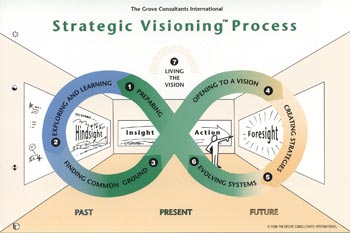 Leadership is a dying art in the world today. The great leaders of the past are found few-and-far between these days. There are some that have been fairly successful that have rose to an iconic status, but have they been truly great leaders or just really successful at running something?
Leadership is a dying art in the world today. The great leaders of the past are found few-and-far between these days. There are some that have been fairly successful that have rose to an iconic status, but have they been truly great leaders or just really successful at running something?
Often there is contention between the skills that a leader needs and what a manager needs. I believe, if you’re not a good leader, you won’t be a good manager, and if you’re not a good manager, you won’t be a good leader. It is my contention that those who apply both of these talents expertly demonstrate what I call, “LeadermentSM.” This is the expert combination of Leadership and Management together.
LeadermentSM | Envision the Shot, Believe in the Shot, Take the Shot
Have you ever heard that Great Leaders possess Great Vision? It’s more than just “having great vision.” It’s believing in that vision and acting upon it. It is easy to think and dream big, but it is risky to go forward with your vision.
A true Leader and Manager, under the LeadermentSM YouniversitySM not only has to be able to envision the future, but believe it is possible, and be willing to take the risk by moving forward and executing on the vision.
As an avid golfer, I understand the power of positive thinking. Golfers can take from 60 to well over 100 shots on a golf course in a single round. Professional understand that every shot requires a routine of mental activity. When preparing for your shot, you stand behind the ball and picture in your mind how the shot will look. Confidence in the shot looking like that comes from practice and experience…if you have the practice and experience, you can believe that the shot will happen as you envisioned it. Then simply trust in your skill to make the shot happen and be willing to accept the consequences if it doesn’t.
You might remember the saying, “It’s better to aim high and miss then to aim low and hit.” Leadership requires all three variables: Vision, Confidence, and Execution. Bringing the three together is a core skill in Leading Yourself in the LeadermentSM YouniversitySM.
Let’s explore these three things a bit closer:
Envision: To picture mentally. Visioning is the act of purposefully thinking about the future of something. Strong leaders and managers are effective at stopping what they’re doing as a routine of their day and envisioning the future. LeadermentSM is about making this routine in your day-to-day life. The best place to practice this is at home. Take a few minutes to sit quietly in a room or in your back yard. Look around and ask yourself if you are happy with the way things look today. Think about the future of your view…what could change over time. If your view could look differently, how would you like it to look. Getting that mental picture doesn’t take hours, days, or weeks–it takes minutes. When you come to work in the morning, envision your day. When faced with a new project, envision the end of the project and the results you expect. Being able to briefly stop what you’re doing and actually think about the future of it is active visioning. Doing that throughout the day is powerful for any leader or manager. I’m not advocating that you spend hours day dreaming at work, just being a little more thoughtful about what you do. Many of us tend to get so wrapped up in what we are currently doing that we seldom think about why or even challenge if we’re doing the right thing.
As part of routine, you should be able to stop often and consider what you’re doing. Think about playing golf, even if you never have before. In a four-hour round of golf, let’s say you take 90 shots–that’s a shot about every 2.7 minutes. To be effective, you must develop a routine of envisioning that shot before you take it. That’s stopping yourself briefly and really thinking about what you expect this to look like. I want you to think about something…professionals normally score in the low 70s and high 60s in golf, while amateurs normally are over 100. Both professionals and amateurs take four hours on average to play a round of golf. This means professionals take about 3.5 minutes to execute each shot and amateurs take over a minute less for each shot. Why? Because they don’t take the time to envision the shot and thus end up taking an average of 30 more swings of their clubs during the same four hours.
That’s a pretty power thought picture isn’t it? If you have eight hours in the day, how would you like to get the same amount of work done 30% better? Simple visioning activities can make this happen–now tell me you think it’s a waste of time!
Above is a simple daily routine of being more thoughtful about what you’re doing and thus becoming better at doing the same amount of work in the same amount of time. However, some things require a bit more dedicated thought. When first given that big project how do you react to it? Do you dive in and get started making it happen or do you stop and take your time thinking about what you’re going to do? I’m not talking about the simple visioning routine above, but more of a dedicated thought process. The extent of the project could dictate taking an hour, a day, or several hours over several days. This is when you need to employee effective visioning approaches and tools. Here are some ideas:
- Silent Brainstorming. Take a blank piece of paper or bring up a blank document on your computer., At the top of the page, write out a sentence or paragraph that essentially describes what task you are about to think about. Clear your mind and remove distractions and take 30 to 60 minutes simply coming up with as many words, phrases, and sentences that come to mind when you look at your purpose on the top of the page. Make sure you set a timer and don’t stop until you’ve run out of time. If you are on a roll and the time runs out, keep going until you’ve run out of ideas. I often do this with groups and have them write each thought on a 3×5 post-it note. Once you have all your ideas, then arrange them in groups that seem to make sense–you can’t go wrong, so just do it. Then go back and rewrite your purpose sentence taking in account each group or write a sentence or paragraph that describes each group and make them bullets to your first sentence/paragraph. Now you have a much deeper understanding of what you’re expected to do.
- Thought Maps. In the center of a page–I like to use 11×17 or butcher block paper–write your task in the center of the page and draw a circle or box around it. Think about the major aspects of that task and write each of them around the central idea, putting them in a box or circle and connecting them to the main idea with a line. If they are related to one another, connect them via lines as well. Continue to re-explore each thought bubble the same way for an hour or so. What you’ll end up with is a very interesting and interconnected mind map of the item you’re faced with. I use thought/mind maps often to stay focused on a big project with lots of things happening at the same time.
- Reflection. Simply stop whatever you are doing, sit quietly for about 15 to 30 minutes, and just think about what it is you’ve been tasked to do. Think of this as expanding the visioning routine I talked about above. After 15 or 30 minutes, quickly write down your thoughts in the form of a sentence or paragraph, or write a main point and then bullet items beneath.
- Interviews. Write down your task and then take it to several people you trust and ask them what they think about the task. Write down their thoughts. After you’ve done your interviews, sit down and refresh your memory by reading what you wrote and then consolidate their thoughts into one paragraph.
These approaches can obviously be used together in any number of ways or you can use all of them. They also can be used over and over again with the same thought at different times or with small groups either in person or over the internet. The size and scope of the task should dictate how much time and effort you spend on this. If you are starting out the year and developing your strategy for the next several years, you probably want to take much more time than if just dealing with a short project.
There are some professional approaches out there that can help you envision the future. Here are just a couple that I like:
Grove’s Strategic Visioning Model. Grove’s model is part of their visual techniques for brainstorming and thought generation. I particularly like their cyclical visioning model because it makes you think about how to reflect on the past, think about the future, and ground yourself in the present. I love using this quote, “Plan for 100 years, live for today.” Grove’s model kind of sums up that quote.
 TRIZ. TRIZ (pronounced “trees”) is an innovative Russian problem solving methodology. I really like the basics of the concept and one specific item has always stuck with me. “Someone somewhere has already solved your problem.” In a nutshell, the solution or approach you’re looking for has already been done, you just have to look for it. Additionally, the TRIZ approach addresses ways of using the problem as part of solution and focusing on contradictions to solve a problem. It’s a very interesting topic that is quickly gaining ground in the western cultures. Back in 2007, there was little out there about TRIZ and now it’s becoming a common approach to innovative thought. I think it provides a nice set of tools for visioning.
TRIZ. TRIZ (pronounced “trees”) is an innovative Russian problem solving methodology. I really like the basics of the concept and one specific item has always stuck with me. “Someone somewhere has already solved your problem.” In a nutshell, the solution or approach you’re looking for has already been done, you just have to look for it. Additionally, the TRIZ approach addresses ways of using the problem as part of solution and focusing on contradictions to solve a problem. It’s a very interesting topic that is quickly gaining ground in the western cultures. Back in 2007, there was little out there about TRIZ and now it’s becoming a common approach to innovative thought. I think it provides a nice set of tools for visioning.
Believe: To have faith, confidence, or trust. It’s great to have big dreams and ideas, but for many of us, this is about as far as we go. Much of this is because of fear–we are afraid of failure. If I openly share my ideas and dreams with others, they might ridicule me. Most of the time I think this because I’m personally challenging these myself. The power of believing is nurtured by experience and mental fortitude. First you have to believe in your vision and then you have to be able to share your belief. Most people will not believe in you if they have no experience in your vision. In my role as a consultant, I often have to share a vision of what I believe can happen to people who don’t believe it’s possible.
In golf, you can have blind faith–which basically means you’ve never experienced it and have nothing to convince yourself that what you believe is actually true, but you believe in it anyway. I believe; however, that this leads to “over confidence.” Practice on the range and the course is what builds confidence. Taking chances and trying new things in the game, especially when nothing is on the line, builds a level of understanding of what you can and cannot do. However, you always have to push yourself to do better. All you have to do is watch professional golfers play and you know that anyone can do better.
So, being able to believe is about having the confidence to know that what you believe is at least possible, if not definitely probable. Confidence comes from experience and knowledge. The combination of these two things makes leaders and managers powerful, because now you can believe in your visions. Gaining the confidence comes from reading, education and training, talking to others, going to conferences, attending webinars, and basically being a voracious consumer of information around the subject. Additionally, practicing and actually performing the thing you believe in greatly builds your confidence. If you’re going to give a speech, they say to practice the speech in front of a mirror and in front of others. If you’re going to practice leading others, do so through volunteering. This is a great way to practice the skills I’m teaching you through the LeadermentSM YouniversitySM.
Execute (Take the Shot): To put into effect, or carry out. If you have a vision and believe in that vision, the final step is to simply act on that vision–just do it! All too often, leaders and manager don’t have the follow through. They come up with great ideas, or at least big ideas, and they talk up a great game, but their ideas never actually materialize. I find this with volunteer leaders in professional organizations all the time. We’ll have a meeting or go to an annual conference and everyone will start dreaming up ideas based on what is being discussed and what they’re learning. They will talk about what they’re going to get done between now and the next gathering, then nothing happens. This is “follow through;” when people do what they say they’re going to do. Some don’t because they don’t know how, some don’t because they’re too busy, some don’t because they’re afraid of failure, some don’t because they’re just lazy; most don’t because of a combination of all these reasons.
In golf, when I have the shot in my mind and I am confident I can make that shot, I line up the shot, address the ball, take one or two practice swings, check my distance, and then I step up and take the shot. If I shank the shot, or pull it left, it is what it is. Examining what you did wrong before you even take the shot is admitting defeat beforehand–failure is sure to follow and thus confirm your belief. Trust and execute.
A great movie and book that I have enjoyed over the years is The Secret. many people have read this book, watched the movie, or both. I definitely would suggest you do the same.
As part of Leading Yourself, The Power of Positive Thinking is a basic tenant of LeadermentSM. Learning to Envision, Believe, and Do in your daily life will greatly improve your ability as a leader and manager.
Now when you think of great leaders think about what styles and concepts of LeadermentSM they employed. What did they do that was so effective…that propelled the masses under them to great things. As we can see, these styles vary in application, but an effective leader and manager should understand and apply all traits in a combined approach as appropriate.
LeadermentSM and YouniversitySM are service marks of Crosscutter Enterprises


Pingback: Self-Efficacy and Locus of Control | John R. Knotts
You are welcome to share. As always I welcome sharing the location to increase readers and comments — i.e. feedback. Thanks!